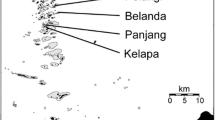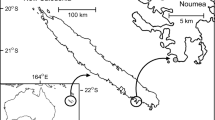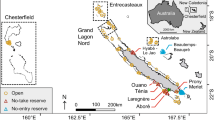Abstract
In coral reef communities, sea urchins and reef fish have a variety of commensal relationships. However, if fish view urchins as a potential form of predator protection, then urchin presence should influence reef fish risk assessment. We investigated whether dusky damselfish (Stegastes nigricans) perceive burrowing urchins (Echinometra mathaei) as a form of predator protection by asking whether and how urchin presence explains variation in flight initiation distance, the distance a fish fled an approaching threat. We found that when individuals were subjected to a high-risk approach (i.e., one that started relatively close to the fish), and urchin density was high, dusky damselfish tolerated a closer approach than when subjected to high risk with low urchin density. However, when there was low risk and high urchin density, the damselfish fled sooner. We conclude that under high risk, damselfish perceive burrowing urchins as providing added security from approaching threats.

Similar content being viewed by others
References
Allen GR (1972) The anemone fishes: Their classification and biology. TFH Publications Inc, Neptune City, NJ
Arvedlund M, Hattori A, Iwao K, Takemura A (2006) When cleanerfish become anemonefish. J Mar Biol Assoc UK 86:1265–1266
Barton K (2019) MuMIn: Multi-model inference. R Package Version 1(43):15
Bates D, Maechler M, Bolker B, Walker S (2015) Fitting linear mixed-effects models using lme4. J Stat Softw 67:1–48
Benevides LJ, Cardozo-Ferreira GC, Ferreira CEL, Pereira PHC, Pinto TK, Sampaio CLS (2019) Fear-induced behavioural modifications in damselfishes can be diver-triggered. J Exp Mar Bio Ecol 514–515:34–40
Blumstein DT (2003) Flight-initiation distance in birds is dependent on intruder starting distance. J Wildl Manage 67:582–587
Blumstein DT (2010) Flush early and avoid the rush: a general rule of antipredator behavior? Behavioral Ecology 21:440–442
Blumstein DT, Samia SM, Stankowich T, Cooper WE Jr (2015) 16 Best practice for the study of escape behavior. In: Blumstein DT, Cooper WE (eds) Escaping from predators: An integrative view of escape decisions. Cambridge University Press, Cambridge, UK, pp 407–420
Brawley SH, Adey WH (1977) Territorial behavior of threespot damselfish (Eupomacentrus planifrons) increases reef algal biomass and productivity. Environ Biol Fishes 2:45–51
Chan Y, Lo S, Quan A, Blumstein DT (2018) Ontogenetic shifts in perceptions of safety along structural complexity gradients in a territorial damselfish. Curr Zool 65:183–188
Chaves LCT, Ormond CGA, McGinty ES, Ferreira BP (2012) Space partitioning among damselfishes in the Caribbean coast of Panama: the role of habitat preferences. Neotrop Ichthyol. https://doi.org/10.1590/S1679-62252012000300017
Cooper WE, Blumstein DT (eds) (2015) Escaping from predators: an integrative view of escape decisions. Cambridge University Press, Cambridge, UK
Goodale E, Beauchamp G, Ruxton GD (2017) Mixed-species groups of animals: Behavior, community structure, and conservation. Academic Press, Cambridge, MA
Graham NAJ, Nash KL (2013) The importance of structural complexity in coral reef ecosystems. Coral Reefs 32:315–326
Jaeger B (2017) r2glmm: Computes R squared for mixed (multilevel) models. R package version 0.1.2.
Kuznetsova A, Brockhoff PB, Christensen RHB (2017) lmerTest Package: Tests in linear mixed effects models. J Stat Softw 82:1–26
Madin EMP, Madin JS, Booth DJ (2011) Landscape of fear visible from space. Sci Rep 1:srep00014
Madin EMP, Precoda K, Harborne AR, Atwood TB, Roelfsema CM, Luiz OJ (2019) Multi-trophic species interactions shape seascape-scale coral reef vegetation patterns. Front Ecol Evol 7:1–11
Mapstone BD, Andrew NL, Chancerelle Y, Salvat B (2007) Mediating effects of sea urchins on interactions among corals, algae and herbivorous fish in the Moorea lagoon, French Polynesia. Mar Ecol Prog Ser 332:143–153
McClanahan TR (1988) Coexistence in a sea urchin guild and its implications to coral reef diversity and degradation. Oecologia 77:210–218
Nunes JACC, Leduc A, Miranda RJ, Cipresso PH, Alves JP, Mariano-Neto E, Sampaio CLS, Barros F (2019) Refuge choice specificity increases with predation risk in a rocky reef fish. J Exp Mar Bio Ecol 520:151207
Patzner RA (1999) Sea urchins as a hiding-place for juvenile benthic teleosts (Gobiidae, Gobiesocidae) in the Mediterranean Sea. Cybium 23:93–97
Patzner RA, Santos RS (1992) Field observations on the association between the clingfifish Diplecogaster bimaculata pectoralis (Briggs 1955) and different species of sea urchins at the Azores. Zeit für Fischkunde 1:157–161
Quadros AL, Barros F, Blumstein DT, Meira VH, Nunes JAC (2019) Structural complexity but not territory sizes influences flight initiation distance in a damselfish. Mar Biol 166:65
R Core Team (2019) R: A language and environment for statistical computing. R Foundation for Statistical Computing, Vienna, Austria
Samia DSM, Blumstein DT (2014) Phi index: a new metric to test the flush early and avoid the rush hypothesis. PLoS ONE 9:e113134
Sammarco PW (1983) Effects of fish grazing and damselfish territoriality on coral reef algae. I. Algal community structure. Mar Ecol Prog Ser 13:1–14
Srinivasan U, Raza RH, Quader S (2010) The nuclear question: rethinking species importance in multi-species animal groups. J Anim Ecol 79:948–954
Thompson AR, Thacker CE, Shaw EY (2005) Phylogeography of marine mutualists: parallel patterns of genetic structure between obligate goby and shrimp partners. Mol Ecol 14:3557–3572
Wickham H (2016) ggplot2: Elegant graphics for data analysis. Springer-Verlag, New York
Ydenberg RC, Dill LM (1986) The economics of fleeing from predators. Adv Study Behav 16:229–249
Acknowledgements
We thank the staff of UC Berkeley Richard Gump South Pacific Research Station for housing and logistical support and the Department of Ecology and Evolutionary Biology for partial support. Research was conducted under permits issued by the Government of French Polynesia (permit approved on 21 November 2019). Dusky damselfish were studied under University of California Los Angeles (UCLA) IACUC Protocol 2001-147-62B (4 November 2019).
Author information
Authors and Affiliations
Corresponding author
Ethics declarations
Conflict of interest
The authors declare that they have no conflict of interest.
Additional information
Publisher's Note
Springer Nature remains neutral with regard to jurisdictional claims in published maps and institutional affiliations.
Topic Editor Alastair Harborne
Supplementary information
Rights and permissions
About this article
Cite this article
Cheh, A., Fadaee, N., Kalhori, P. et al. Love thy prickly neighbor? Sea urchin density affects risk assessment in damselfish. Coral Reefs 40, 21–25 (2021). https://doi.org/10.1007/s00338-020-02035-0
Received:
Accepted:
Published:
Issue Date:
DOI: https://doi.org/10.1007/s00338-020-02035-0




